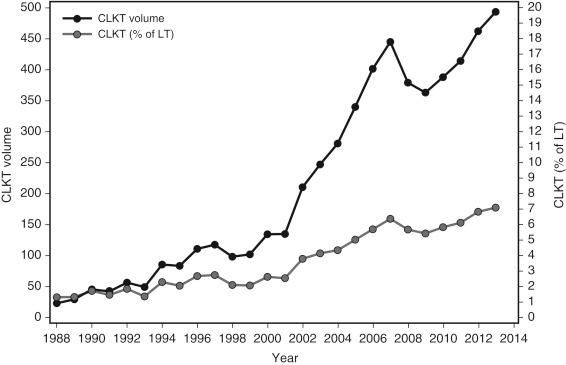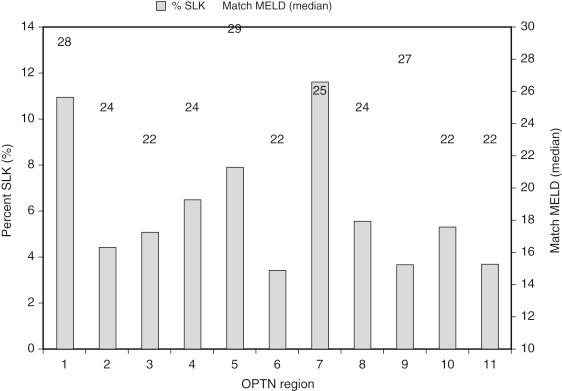Physical Address
304 North Cardinal St.
Dorchester Center, MA 02124
Irreversible kidney failure was once considered an absolute contraindication to liver transplantation alone. Three decades ago the first combined liver and kidney transplantation (CLKT) was performed by Margreiter et al. Interestingly, the recipient, a 32-year-old man with hepatitis B cirrhosis, had previously undergone a kidney transplantation 6 years earlier, making this first case both a subsequent and simultaneous transplant. Thirty years later, this patient remains alive and well. Multiple centers worldwide have also reported successful long-term outcomes with the combined procedure. This chapter provides a detailed look into CLKT, together with an immunological perspective, the indications, and outcomes. Finally, an alternative to CLKT, kidney after liver transplantation (KALT), will be addressed.
A substantial increase in the number of CLKTs has been realized over the past decade ( Fig. 63-1 ). This is in large part due to the introduction of the Model for End-Stage Liver Disease (MELD) scoring system, which prioritizes renal dysfunction (i.e., serum creatinine level). With MELD implementation the number of CLKTs tripled from 2001 to 2006. Additionally, an initial study reported a decline in patient survival after CLKT during the early MELD era. In response to these results, a consensus conference was held in 2007 to establish baseline CLKT selection criteria. Interestingly, a drop in volume was seen in 2008, likely the result of this new published awareness and backlash from the kidney transplant community. The decline was short-lived, however, and the numbers are once again on the rise with CLKT accounting for 7.1% of all liver transplants in 2013.

Currently there are 837 patients listed for CLKT, or 5.3% of listed liver transplant candidates. Because of the higher MELD scores accrued by patients with renal failure, a higher proportion of CLKT candidates (over liver transplant alone) are likely to be transplanted. The growing number of CLKT is not only a consequence of the MELD allocation system, but also due to individual center practices. In a national survey of multiple transplant centers by Nadim et al, a lack of consistent criteria used to select CLKT candidates was disclosed, with certain regions accounting for a higher proportion of cases ( Fig. 63-2 ).

Liver transplants have been performed successfully despite a positive T- or B-cell crossmatch (XM) result. Why the liver allograft is resistant to hyperacute rejection is not fully known, but hypotheses include the liver’s ability to neutralize HLA antibody-antigen complexes with its abundant number of Kupffer cells and its known regenerative capacity, and its dual blood supply (i.e., sinusoidal architecture), allowing for greater absorption of circulating antibodies. However, some centers have reported adverse outcomes across a positive XM, including an increased incidence of biliary complications, chronic rejection, and decreased graft survival. Still, these findings have not been sufficiently reproduced to deny a patient a liver transplant because of a positive XM.
During the genesis of kidney transplantation, ABO-incompatible transplants resulted in a rapid and irreversible rejection. Kidney transplants were therefore limited to donor-recipient ABO compatibility. By the 1960s it became clear that transplant recipients had preformed circulating anti–donor HLA antibodies. Thus XM testing was developed to test for preformed cytotoxic antibodies against a potential donor. Staggering results of kidneys transplanted across a positive XM (24 of 30 failed) compared to a negative XM (8 of 195 failed, P < .001) were found in a hallmark paper by Patel and Terasaki.
With CLKT the proposed hypothesis was that the liver allograft provided protective immunity to the kidney, and thus there was no role for XM testing. The theory appeared to be confirmed as reduced rates of acute rejection episodes in the kidney allografts of CLKT were clinically apparent. However, recent detailed analyses have turned the tide. In a retrospective Scientific Registry of Transplant Recipients (SRTR) review of CLKT recipients from 1995 to 2008, Askar et al reported a significant negative association of presensitized recipients (positive T-cell XM or panel-reactive antibody > 10%) with kidney graft and patient survival. In a review of CLKT recipients at Baylor, the presence of preformed or de novo Class II donor specific antibodies was associated with compromised patient, liver, and kidney graft survival. Thus, in sensitized recipients of CLKT, the liver may not protect the renal allograft as was once believed.
At Baylor, crossmatches on all liver transplantations are conducted with results provided retrospectively in most instances. In cases with a positive XM, an induction agent is administered postoperatively followed by a more diligent approach to immunosuppression. Currently we are compiling data on crossmatches taken before liver implantation, between liver and kidney implantation, and after transplantation. This may help in answering the questions whether, when, and under which circumstances the liver allograft converts a positive XM.
Although the anticipation is for both grafts to function immediately after implantation, sometimes return of kidney function is delayed. Thus, when dealing with immunosuppression, preservation of the renal allograft is always at the forefront. A delay of function can have dire consequences, such as the need for dialysis, prolonged intensive care unit stay, and increased infectious complications. As with post–liver transplant renal failure, CLKT recipients requiring hemodialysis after transplantation have a significantly poorer outcome.
Because of the addition of the renal allograft, some centers follow their kidney transplant protocols with upfront use of induction agents. At Baylor the immunosuppression protocol for CLKT recipients follows the indication for the liver transplant. Should there be evidence of delayed kidney function, a renal-sparing regimen is employed. Calcineurin inhibitor introduction is delayed in lieu of thymoglobulin induction. Steroids are weaned gradually with a low-maintenance daily dose (5 mg) long-term.
Become a Clinical Tree membership for Full access and enjoy Unlimited articles
If you are a member. Log in here